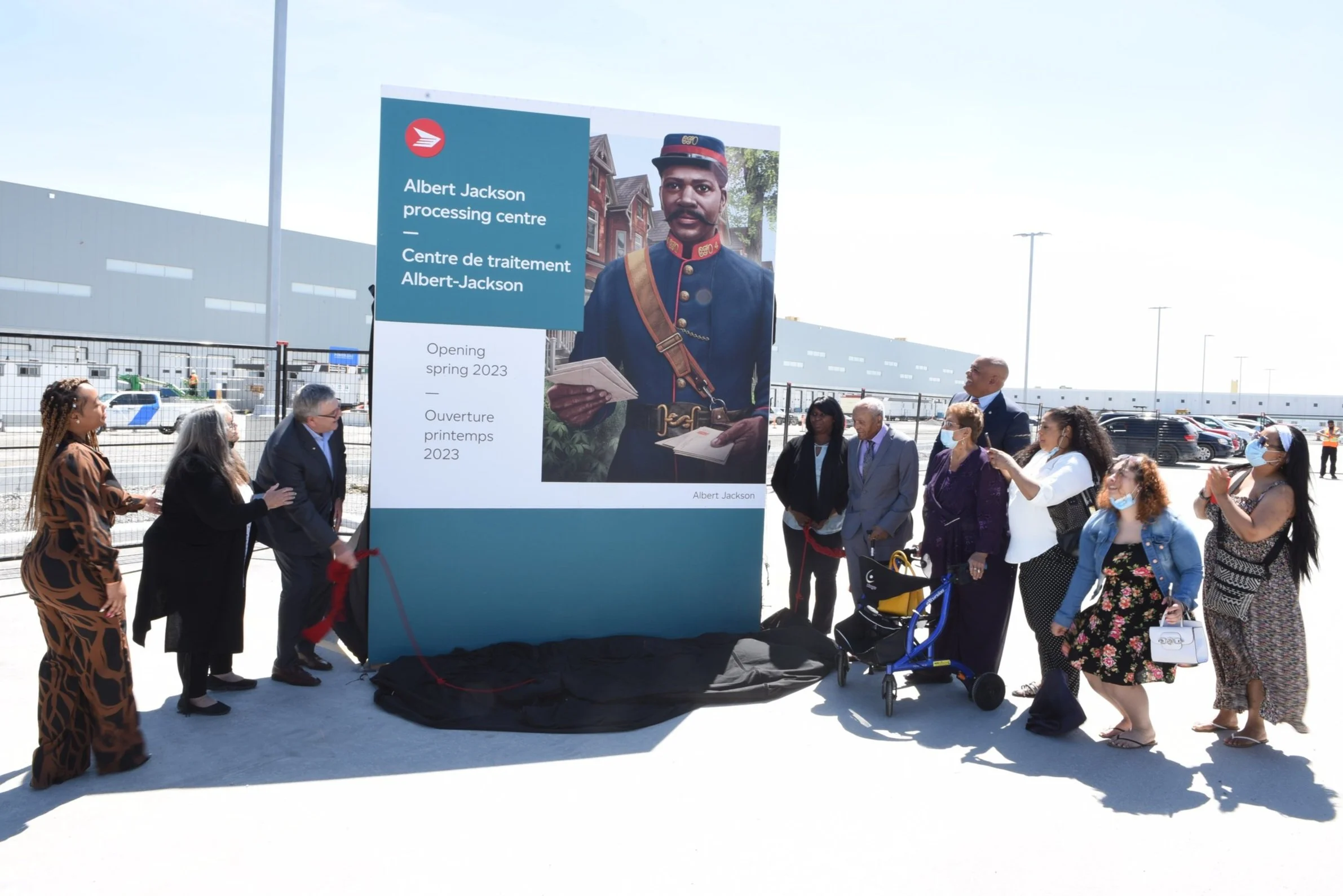Canada Post new processing centre to bear Albert Jackson's name
May 18, 2022
The national postal service largest parcel sorting facility will bear the name of Albert Jackson, believed to be Canada’s first Black letter carrier.
Expected to be completed early next year, Canada Post first zero-carbon plant will process more than a million packages a day, which is 50 per cent more than at the Gateway facility in Mississauga that is currently the largest plant.
The $470 million 585,000 square feet state-of-the-art flagship facility, located at 1395 Tapscott Rd. in Scarborough is nearly the size of six Canadian football fields.
Besides being an important piece of Canada Post future, the Albert Jackson Processing Centre, noted the company’s President and Chief Executive Officer Doug Ettinger, honours the past.
While understanding the important role it plays in the lives of Canadians, he said the company has constantly evolved to meet their changing needs.
“But to truly serve all Canadians, the postal service must also respond to the changes in society and reflect the country we serve,” Ettinger pointed out at a ceremony on May 12 to introduce the new facility. “This requires us to stretch beyond our traditional role and do our responsibility to the country through a wider lens. Through this wider lens, I fundamentally believe Canada Post can be a positive force for change across the country.
“…Canadians now, more than ever, expect large organizations like ours to lead in ways that go beyond our simple products and services. They want us to reflect their shared values and to help make Canada greener, stronger and more inclusive. As Canada continues to evolve, so too will Canada Post.”
With the Gateway plant stretched beyond capacity, Ettinger said the new facility will be a critical hub for Canada Post.
Canada Post President & CEO Doug Ettinger (Photo by Ron Fanfair)
“It will help improve service, reduce our environmental footprint and enhance the overall work experience for our employees,” he said. “The last few years have shown that we have to expand our parcel capacity across our network to keep pace with the surging demand, particularly in E-commerce. This is especially true in the Greater Toronto Area where approximately 40 per cent of all parcels in Canada originate.”
Parcel capacity will increase by more than 50 per cent in the next seven years to manage the forecasted growth and online shopping beyond 2030. Packages arriving at the plant will be processed and ready for dispatch in about four minutes.
The largest industrial project in Canada with the Zero Carbon Building Standard designation will have rooftop solar panels to generate clean renewable energy, 10 electric vehicle charging stations and infrastructure to support the five-ton fleet electrification.
With employee wellness a priority for many organizations, the facility will include six fully enclosed rest pods, a multi-faith room, a wellness fitness centre and gender-neutral washrooms. Skylights on the roof and exterior walls will provide natural light.
Member of Parliament Michael Coteau represented the federal government at the unveiling ceremony.
“This building is very important,” he said. “It is a way of telling people that things can change in Canada and there are things that are worth fighting for.”
Having the plant in her ward could not have made Scarborough North Councillor Cynthia Lai prouder.
“The facility represents the future that my ward wants to help build,” she said. “It is designated and designed to support economic growth while focused on sustainability.”
Jan Simpson, who in 2019 made history as the first female Black Canadian union leader, is the President of the Canadian Union of Postal Workers (CUPW) that represents approximately 60,000 employees, the majority Canada Post workers.
CUPW President Jan Simpson (Photo by Ron Fanfair)
“I am here because of Albert Jackson,” she said. “When we learned about his story over 10 years ago, we knew that his legacy needed to be shared far and wide. In the last decade, CUPW has told the story of the first Black postal worker through commemorative posters, bulletins and supportive campaigns and initiatives to ensure his legacy is known. His story is not just about the struggle against racism. It is also a struggle for dignity, respect, fairness and the importance of communities coming together to fight against inequality.”
About 60 Jackson family members, including grandson Lawrence Jackson and great great granddaughters Tamara and Francine Jackson, attended the event.
Tamara Jackson (Photo by Ron Fanfair)
Tamara Jackson thanked her great great grandfather for opening doors for future generations.
“A legacy is not leaving something for people, but in people,” she said. “You have put the Jackson name on the map and that makes me immensely proud. Generations of people will know you and what basic human rights you stood for. Thank you for persevering even though I am sure there were days you wanted to give up, thanks for your strong will and teaching us we are worth more and we are more than just our skin colour, and thanks for showing us that we deserve to be here just as you deserved to be there on your first day (on the job at Canada Post) in 1882.”
Her father and brother, Arnold and Tremayne, were Canada Post employees while her mother, Vanessa, is employed with the national postal carrier.
Francine Jackson said her great great grandfather was more than a trailblazer.
“He was and is our hero and beloved ancestor,” she added. “Today is a proud and exciting day for all of us.”
Canada Post President & CEO Doug Ettinger (third from left), CUPW President Jan Simpson (fourth from left) and MP Michael Coteau (seventh from left) joined Albert Jackson family members at the unveiling of the new postal processing centre that will bear the name of the man believed to be Canada’s first Black postman (Photo by Ron Fanfair)
Former Canadian television journalist Jojo Chintoh said the naming of a federal building after a Black man is enormous.
“Just imagine what he went through just to get that job and remain with it for over three decades,” said Citytv’s first Black reporter. “There was a time when the only job a Black man in Canada could get was working on the railroad as a porter. To be recognized with a building this size is monumental and should not be taken for granted.”
When Jackson’s mother – Ann Maria Jackson who was enslaved in Delaware – learned that her master intended to sell four more of her children (her eldest two had already being sold), she hurriedly gathered her remaining seven kids and embarked on the challenging journey to Canada. They arrived in 1859 and the two children who were sold somehow found their way to Toronto where the family was united.
Albert, the youngest of the siblings, attended school and obtained employment as a mail carrier in 1882. When his White colleagues refused to train him, he was given a menial inside job as a hall porter.
A federal election was looming at around the same time and the postmaster, who was a close political ally of then Prime Minister Sir John A. MacDonald, promised to train the recruit in order to secure the nearly 60 Black votes in the Toronto Centre riding held by the Conservatives. The postmaster had earlier accused Liberal candidate J.D. Edgar of exploiting the situation to secure votes.
The ploy worked in favour of Jackson who spent the next 36 years until his retirement as a mailman. He died in 1918 at age 60.
Four years before his passing, he bought a home – one of 12 properties he owned in the city – at 213 Brunswick Ave. that family members resided in until 1970.
“His story is one of perseverance, overcoming barriers and what people can do when given the same opportunities as everybody else,” said Ettinger. “Yet, this is also a story of how his workplace let him down big time. But we choose to share this story as tough as it is so we can learn from it going forward. I can assure you we will do better. Albert Jackson’s legacy reminds us of how important it is to remain committed to diversity, equality, inclusion and respect in the workplace. This is a course we are on and will stay on and push even harder going forward. We hope the naming of this building will help show all of our employees that they too are welcomed and included, that we can celebrate our differences and be united as colleagues and that we can transform the future which we need to do.”
In addition to a CUPW poster honouring him in 2013, Jackson’s legacy has been recognized with a Harbord Village laneway bearing his name, a Heritage Toronto historical plaque at 26 Lombard St., where Jackson picked up mail for delivery for 36 years, a book written and illustrated by Clinton Street Public School Grade One students and a commemorative stamp.










